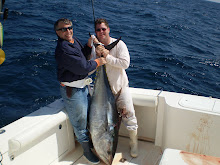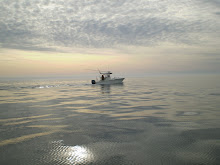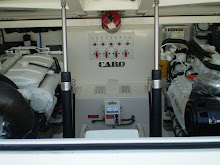
By Jim Field
I have been doing a bit of research on stripers for an ongoing project; thought I'd share the fact sheet I put together. What points of learning, you might ask, did I find particularly interesting? Well, the fact that the Chesapeake Bay and its tributaries are the primary spawning and nursery area for 70-90% of the Atlantic coast stocks. That the largest striped bass ever caught was a 125 pound female landed on the North Carolina coast in 1891. That the largest Maryland record fish was 67 pounds, 8 ounces. And the oldest fish ever caught was 31 years of age. Hope you benefit from reading the other bits of information.
Striped Bass
Morone saxatilis
aka Rockfish, Rock, Striper
•Striped bass is a silvery fish that gets its name from the seven or eight dark, continuous stripes along the side of its body.
•Striped bass can grow as long as 60 inches.
•The largest recorded striped bass was a 125 pound female caught on the North Carolina coast in 1891.
•The current Maryland Chesapeake Bay record striped bass is 67 lbs., 8 oz.
•The oldest ever recorded was 31 years of age.
Distribution
•On the Atlantic coast, striped bass range from St. Lawrence River, Canada to St. Johns River, Florida, although they are most prevalent from Maine to North Carolina.
•Striped bass tend to move north to nearshore waters of the New England coast during the summer, and south to the North Carolina/Virginia Capes during the winter.
•The east coast migratory population is composed of three major stocks - Hudson, Chesapeake, and Roanoke.
•The Chesapeake stock:
o The striped bass stock within Chesapeake Bay is composed of pre-migratory fish, primarily ages 10 and younger, and coastal migratory striped bass range in age from age 2 to more than age 30.
o Mature resident and migratory striped bass move into tidal freshwater in early spring to spawn.
o After spawning, migratory fish return to the coast.
o Most spend the summer and early fall months in middle New England near-shore waters.
o During the late fall and early winter, coastal striped bass migrate south to winter off the North Carolina/Virginia Capes.
Food Preference
•Larvae feed on zooplankton.
•Juveniles take in small shrimps and other crustaceans, annelid worms, and insects.
•Adults feed on a wide variety of fishes, crustaceans, squids, mussels, and worms.
•Feeding ceases shortly before spawning.
Spawning
•Female striped bass can mature as early as age 4; however, it takes several years (age 8 or older) for spawning females to reach full productivity.
•Males can mature as early as age 2.
•Once a mature female deposits her eggs, they are fertilized by milt ejected from a mature male.
•Spawning is triggered by an increase in water temperature and generally occurs in April, May and early June in Chesapeake Bay.
•The fertilized eggs drift downstream with currents and eventually hatch into larvae within 2 to 3 days.
•The larvae begin feeding on microscopic animals during their downstream journey.
•After their arrival in the nursery areas, located in tidal reaches of the spawning rivers, they mature into juveniles.
•They usually remain in Chesapeake Bay for two to five years, and then migrate to the Atlantic Ocean.
•With warming water temperatures in the spring, mature fish start their spawning runs in freshwater rivers and streams to complete their life cycle.
•Chesapeake Bay and its tributaries are the primary spawning and nursery area for 70-90% of the Atlantic coast stocks of striped bass.
•Other important spawning areas include the Hudson River in New York and rivers along the North Carolina coast.
Other Facts
•Striped bass (Rock Fish) is Maryland's official state fish.
•This is Maryland's most important commercial and recreational fish species.
•The Atlantic striped bass management program has enjoyed successes like no other. In a little more than 15 years, the resource has rebuilt from a historic low of about 20 million pounds to an historic high of 160 million pounds.
•Striped bass were so plentiful at one time, they were used to fertilize fields.









No comments:
Post a Comment